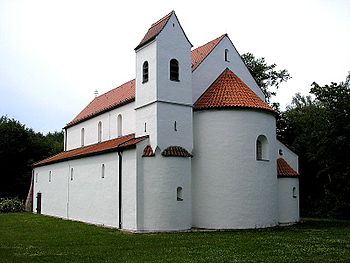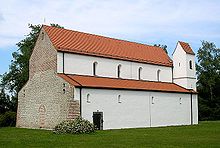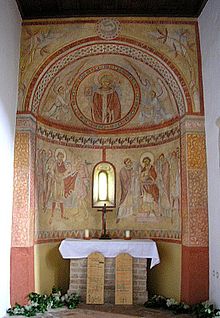St. Peter and Paul (Petersberg)
The Petersberg Basilica is a Roman Catholic branch church on the Petersberg near Petersberg ( Erdweg municipality ), a wooded ridge in the Dachau hill country in Upper Bavaria . The former monastery church is one of the most important Romanesque church buildings in old Bavaria . However, today's appearance goes back largely to a restoration in 1906/07, during which the original structure of the basilica could almost be reconstructed.
history
The high medieval castle Glaneck (Gloneck) of the Counts of Scheyern was originally located on the hilltop above the fork of the old Roman road from Augsburg to Freising . Countess Haziga founded a Benedictine monastery in Bayrischzell in 1077 , which was relocated to Fischbachau in 1087 because of the unfavorable location . At the beginning of the 12th century, the Counts Otto III. and his relative Berthold von Burgeck opened the castle and donated it to the Benedictine order . The two donors also donate a large part of their goods to the monastery. In 1104 a convent of Hirsau monks moved into the castle stables . Fischbachau had also proven to be an unfavorable location for the monastery. The monastery church was consecrated in 1107 by the Freising Bishop Heinrich von Eberstein-Tengling . The consecration was carried out again in 1110 by the Archbishop of Salzburg, Konrad von Abensberg , as Bishop Heinrich had been banned by the Pope because of his friendly attitude towards the emperor in the investiture dispute .
When the Lords of Scheyern moved into their new castle near Aichach ( Wittelsbach Castle ) a little later , the monks left the young monastery again in 1123 in order to finally settle on the site of the former Scheyern Castle. The monastery on the "Petersberg" existed for a total of only 16 years.
However, the Petersberg remained in the possession of the Scheyern Monastery until around 1340 . From here, two priests took care of pastoral care in the middle Glonn Valley. Then the basilica was placed under the parish of Walkertshofen .
In 1730 the medieval basilica was converted to Baroque style . The most noticeable change was the mighty gable roof , which now combined the three naves. The windows were also adapted to contemporary tastes. The interior was decorated with stucco and new altars were added to the church.
In the 19th century the church was supposed to be demolished because of its poor condition. Around 1864 three neighboring pastors inspected the former monastery church and saw no possibility of preservation. A cross should be erected in place of the church.
In 1869 Joseph Anton Immler became pastor of Walkertshofen. He recognized the historical and art-historical value of the building and initiated an initial restoration.
In 1907 the 800th anniversary of the Petersberg was celebrated. The extensive renovation of the basilica began in 1906 under Pastor Josef Köpf. The remains of the frescoes were uncovered and then added. Due to the early evacuation of the monks, the painting of the side apses was apparently not done in the High Middle Ages . Here the restorer was able to develop image programs around Saints Martin and Benedict in accordance with the wishes of the client .
The upper storey could be rebuilt and the basilica shape restored. The baroque stucco was also removed and the altars removed. The restoration measures at that time shape the picture to this day.
The last major restorations were carried out in 1980/81 (exterior renovation) and 1984 (interior).
Today the Petersberg basilica belongs to the Erdweg parish association, to which the old Walkertshofen parish was incorporated, and is administered by the Haus Petersberg Foundation, which also runs the Petersberg Catholic Rural College.
description
The basilica is located on the plateau of the high medieval Glaneck castle stables. The castle square is separated from a wooded range of hills by a wide and deep neck ditch . A later earth bridge enables access to the church and the "Upper House" of the Catholic rural adult education center Petersberg. The larger "Lower House" is below at the foot of the hill.
The Petersberg Basilica is a typical pillar basilica with no transepts of the reduced old Bavarian scheme. The structure is only about 24 m long and 12 m wide. The model of the previous church in Fischbachau is particularly clear in the floor plan. The small bell tower above the south apse was probably built in the 18th century as part of the Baroque era.
The exterior is plastered white, but the west facade has been left as stone. The high medieval parts consist of quarry stone , the later additions of brick masonry. The clogged west portal and a small round window are clearly visible. These building records refer to the baroque reconstruction of the church, which was only reversed in the early 20th century. Two portals in the west of the aisles provide access today. Both side aisle walls had to be renewed in 1906 and 1980/84.
Interior
The upper arcade of the basilica is also an extensive reconstruction. The original masonry was removed during the Baroque era in order to bring the three naves under one roof. The simple wooden ceiling was allowed to be a little lower than the medieval model.
The main nave opens in five arched arcades to the side aisles. The change of pillars on the second pair of pillars from the west is remarkable. Here the pillars are designed as round pillars with capitals without transom , the remaining pairs of pillars have square cross-sections. The pillars were built up from locally available molasse sandstone , some of the quarry stone material for the walls had to be brought from the Danube region. The interior is also plastered in white, the pillars were left exposed to stone during the last renovations.
Frescoes
The frescoes of the three apses were only created during the renovation in 1906/07. The performing artist Hans Haggenmiller could only orient himself in the main apse of the old structure, which was hidden under seven to eight layers of plaster. The pictures in the side apses are completely new creations, but they are so successful that the frescoes are still sometimes mistaken for supplemented originals in specialist literature. The "original" parts of the main apse are so heavily painted that they have to be regarded as reproductions. The depicted corresponds to a ' Majestas Domini ', with Jesus in a mandorla, surrounded by the four evangelist symbols, a popular pictorial scheme of the main apse in the Middle Ages. Prof. Haggenmiller oriented himself here on the Romanesque book illumination and the frescoes in the convent under Regensburg . The overall impression is quite medieval, but the modern treatment of the faces in particular clearly points to the early 20th century.
The enthroned Mother of God with the angels in the main apse, the martyrdom of the princes of the apostles Peter and Paul and the winged evangelist symbols (man, lion, bull, eagle) still remind of the original pictorial program . The Dehio manual describes these parts as restored originals. The crucifixion of St. Peter and the beheading of St. Paul next to the window have their models in the medieval stock. Christ is enthroned as ruler of the world in the mandorla in the dome .
In the north apse you can see scenes from the life of St. Martin , about the division of the coat. The south apse is decorated with a representation of the life of St. Benedict.
Only a few pieces of the former furnishings were left in the church. In the north aisle there is a remarkable late Gothic carved figure of Our Lady (beginning of the 16th century) from the circle of the "Master of the Blutenburg Apostles ".
Catholic country folk high school

The Katholische Landvolkshochschule Petersberg was founded after the Second World War by Munich Auxiliary Bishop Johannes Neuhäusler together with the rural youth chaplain Emmeran Scharl and Gabriele Weidl. It started operations in the Indersdorf Monastery in 1951 and moved to the new building (today: Upper House) on Petersberg in 1953. The so-called lower house was built at the foot of the mountain in 1965 and was almost completely replaced by a new building in 2000. The von Soden-Fraunhofen family made a significant contribution to the establishment of the property by donating the land and is still connected to the Petersberg today.
The Landvolkshochschule is run by the Haus Petersberg Foundation, a church foundation under public law of the Archdiocese of Munich and Freising. The Archdiocese, the Katholische Landvolk, the Katholische Landjugend and the Petersberg-Gemeinschaft are connected to the Petersberg through the organs of the foundation.
Petersberg Sculpture Path
Since 2007, the 900-year year of consecration of the basilica, there has been a 200 m long sculpture path on the subject of "Being a human being" from the lower to the upper house or the basilica . Here the attempt is made to combine sustainable traditional Christian values with creative forms of expression of spirituality . The sculpture path creatively implements the spiritual experiences of ten stations in life. These are: change, new beginnings, hurt, healing, encounter, decision, farewell, home, longing and transitions.
Meditative hiking trail
In 2012, a meditative hiking trail with the motto “GO INTO YOURSELF” or “INTO YOURSELF” was laid out between the former Petersberg monastery and the Altomünster monastery . The 9 km long path includes 14 stations with works of art, information boards and sayings for contemplation and reflection. Each station is also equipped with a seat.
7 Monasteries Way
The Petersberg is also one of the cycle path stations of the 7-Klöster-Weg , which connects seven existing or former monasteries in the Dachauer and Wittelsbacher Land . The aim of this 100 km long bike path is to bring the monasteries back to consciousness and make them tangible. The seven monasteries: Monastery Schönbrunn in Röhrmoos , Monastery Weichs , Kloster Indersdorf , Kloster Petersberg, altomünster abbey , Kloster Maria Birnbaum in Sielenbach and monastery taxa in Odelzhausen .
literature
- Georg Brenninger: The Romanesque basilica on the Petersberg near Dachau. Schnell & Steiner, Kleiner Kunstführer No. 831, 8th edition, Regensburg 2003, ISBN 3-7954-4558-2 .
- Georg Dehio: Handbook of the German art monuments: Bavaria IV: Munich and Upper Bavaria. 3rd edition, Munich, Berlin 2006. ISBN 3-422-03115-4 .
- Gottfried Weber: The Romanesque in Upper Bavaria. Pfaffenhofen 1985, ISBN 3-7787-3258-7 .
- Local history Eisenhofen e. V. (Ed.): EISENHOFEN - local history Eisenhofen, Hof, Petersberg . 500 pages, 2015.
- Kunstverlag Josef Fink (ed.): Basilica on the Petersberg near Dachau . 1st edition, Lindenberg 2007, ISBN 978-3-89870-438-0 .
- Jakob Mois : Poetry and truth about the Romanesque paintings in the Petersberg basilica . In: Amperland , 1975, pp. 9-11.
- Norbert Göttler: The country folk high school on the Petersberg . In: Amperland , 1986, pp. 347-349.
Individual evidence
- ↑ Birgitta Unger-Richter: Basilica on the Petersberg . In: Basilica on the Petersberg near Dachau . Kunstverlag Josef Fink, Lindenberg 2007, p. 4
- ↑ The Petersberg - learn to live to believe - (official website of the Landvolkshochschule)
- ↑ Petersberg Sculpture Path - “Being human with passion” - (Catholic rural folk high school)
- ↑ InSichGehen - A meditative hiking trail between the old monastery locations of Petersberg and Altomünster ( Memento of the original from February 1, 2014 in the Internet Archive ) Info: The archive link was inserted automatically and has not yet been checked. Please check the original and archive link according to the instructions and then remove this notice. - (PDF flyer)
- ↑ The "7 Klöster Weg" in the Dachauer and Wittelsbacher Land ( Memento from 23 May 2015 in the Internet Archive ) - (Verwaltungsgemeinschaft Odelzhausen , accessed on 23 May 2015)
Web links
- Basilica Peter and Paul on the Petersberg - (Hans Schertl)
- Basilica am Petersberg - (Catholic Landvolkshochschule Petersberg)
Coordinates: 48 ° 20 ′ 25.4 ″ N , 11 ° 17 ′ 47.4 ″ E




